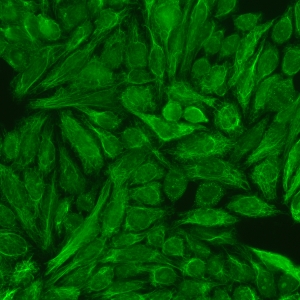AC-16 - Fibrillar filamentous
Descrição
Staining of microtubules and intermediate filaments spreading from the nuclear rim. e.g. anti-cytokeratin, anti-vimentin, anti-tropomyosin.
Associação Antigênica
vimentin, cytokeratins, tropomyosin.
Doença Associada
infectious or inflammatory conditions, long-term hemodialysis, alcoholic liver disease, SARD, psoriasis, healthy controls.
Relevância Clínica (Primeiro Nível)
Found in various diseases, but AC-16 is not typically found in SARD.
Antigens recognized include cytokeratins 8, 18, & 19, tubulin, and vimentin; specific immunoassays for these autoantibodies are currently not commercially available.
Relevância Clínica (Segundo Nível)
Higher levels of anti-cytokeratin 8, anti-cytokeratin 18 and anti-cytokeratin 19 antibodies reported in patients with AIH compared with normal volunteers and patients with chronic active HCV infection.
Autoantibody against the 45-kDa human cytokeratin 18 protein reported in 76% of chronic obstructive pulmonary disease patients and 24% of control subjects.
Higher levels of anti-cytokeratin 19 antibodies reported in patients with idiopathic pulmonary fibrosis and pulmonary fibrosis associated with collagen vascular disorders compared with healthy controls, patients with chronic bronchitis, and patients with pneumonia
Reported in 50% of sera from patients with alcoholic liver disease, but in only 7 – 13% of sera from patients with chronic active hepatitis, PBC, and healthy controls.
Reported in high prevalence in patients with certain parasitic infections.
IgM autoantibodies to tubulin have been described in patients with infectious mononucleosis and healthy adults.
IgG autoantibodies to tubulin have been detected specifically associated with young age onset of nasopharyngeal carcinoma.
Reported in a single case of a patient with a progressive sensorimotor neuropathy.
High levels of polyclonal autoantibodies to tubulin are associated with acquired demyelinating polyneuropathies.
Low levels of autoantibodies are reported in healthy controls.
Reported as one of the biomarkers for Sydenham’s chorea and PANDAS syndrome
IgG and IgM autoantibodies to vimentin have been reported as relevant markers in patients with neurofibromatosis type 1 and associated tumors.
Rheumatoid arthritis and other inflammatory arthritis patients may have antibody to citrullinated isoforms of vimentin; it is, however, unlikely that these antibodies show the AC-16 pattern.
Reported to occur after solid organ transplantation and implicated in rejection and poor outcome in cardiac or renal transplantation.
Most reports describe autoantibodies directly binding to specific antigens (i.e., antigen-specific immunoassays) and none actually shows correlations with the AC-16 pattern as such; specific immunoassay for these autoantibodies are currently not commercially available.
Referências
Besarani D, Cerundolo L, Smith JD, et al. Role of anti-vimentin antibodies in renal transplantation. Transplantation 2014;98:72-8.
Connolly AM, Pestronk A. Anti-tubulin autoantibodies in acquired demyelinating polyneuropathies. J Infect Dis 1997;176:S157-9.
Fujita J, Dobashi, N Ohtsuki Y, et al. Elevation of anti-cytokeratin 19 antibody in sera of the patients with idiopathic pulmonary fibrosis and pulmonary fibrosis associated with collagen vascular disorders. Lung 1999;177:311-9.
Howard MK, Gull K, Miles MA. Antibodies to tubulin in patients with parasitic infections. Clin Exp Immunol 1987;68:78-85.
Jalbout M, Bel Hadj Jrad B, Bouaouina N, et al. Autoantibodies to tubulin are specifically associated with the young age onset of the nasopharyngeal carcinoma. Int J Cancer 2002;101:146-50.
Karsenti E, Guilbert B, Bornens M, et al. Antibodies to tubulin in normal nonimmunized animals. Proc Natl Acad Sci U S A 1977;74:3997-4001.
Kirvan CA, Cox CJ, Swedo SE, et al. Tubulin is a neuronal target of autoantibodies in Sydenham's chorea. J Immunol 2007;178:7412-21
Kotaska K, Petrak B, Kukacka J, et al. Anti-vimentin antibodies and neuron-specific enolase in children with neurofibromatosis type-1. Neuro Endocrinol Lett 2007;28:761-4.
Kuo YB, Chang CA, Wu YK, et al. Identification and clinical association of anti-cytokeratin 18 autoantibody in COPD. Immunol Lett 2010;128:131-6.
Kurki P, Miettinen A, Salaspuro M, et al. Cytoskeleton antibodies in chronic active hepatitis, primary biliary cirrhosis, and alcoholic liver disease. Hepatology 1983;3:297-302.
Mahesh B, Leong HS, McCormack A, et al. Autoantibodies to vimentin cause accelerated rejection of cardiac allografts. Am J Pathol 2007;170:1415-27.
Manfredini E, Nobile-Orazio E, Allaria S, et al. Anti-alpha- and beta-tubulin IgM antibodies in dysimmune neuropathies. J Neurol Sci 1995;133:79-84.
Mead GM, Cowin P, Whitehouse JM. Antitubulin antibody in healthy adults and patients with infectious mononucleosis and its relationship to smooth muscle antibody (SMA). Clin Exp Immunol 1980;39:328-36.
Murota M, Nishioka M, Fujita J, et al. Anti-cytokeratin antibodies in sera of the patients with autoimmune hepatitis. Clin Exp Immunol 2001;125:291-9.
Stubbs EB Jr., Fisher MA, Siegel GJ. Anti-tubulin antibodies in a sensorimotor neuropathy patient alter tubulin polymerization. Acta Neuropathol 1998;95:302-5.
Tilleman K, Van Steendam K, Cantaert T, et al. Synovial detection and autoantibody reactivity of processed citrullinated isoforms of vimentin in inflammatory arthritides.
Rheumatology 2008;47:597-604.






